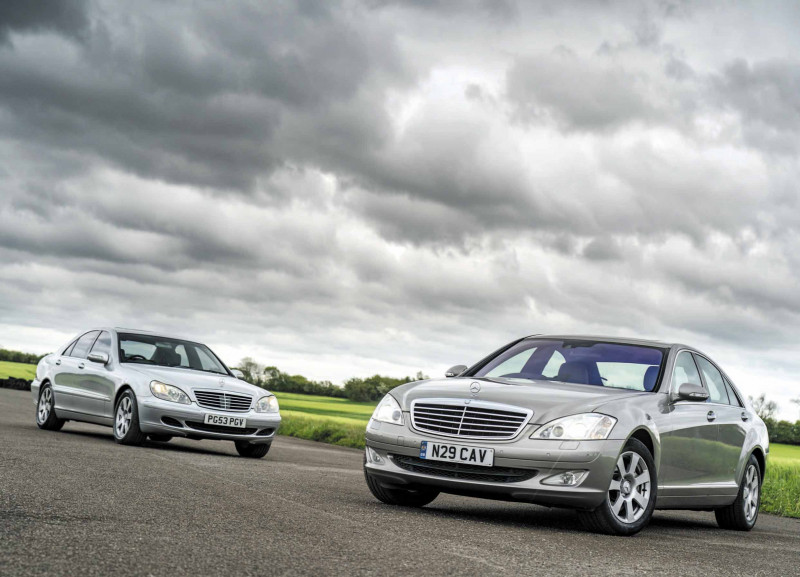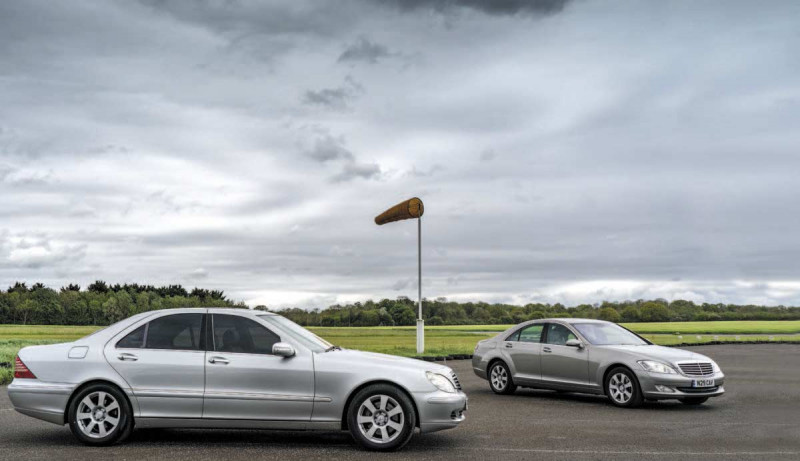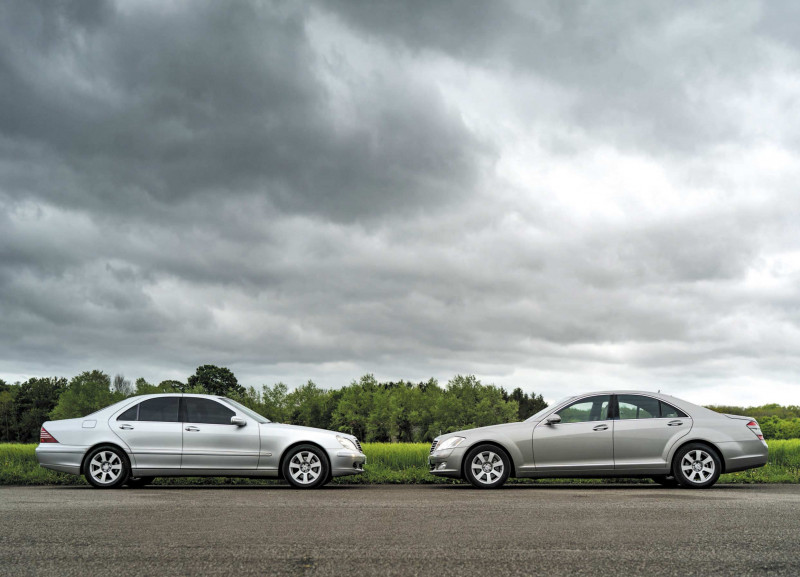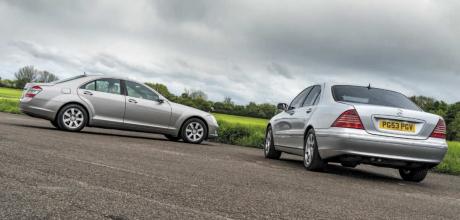1999 Mercedes-Benz S320 CDI W220 vs. 2005 Mercedes-Benz S320 CDI W221
They may be a few generations old, but the now highly affordable 220- and 221-series S-Classes remain hugely impressive drives, with space and performance to spare, and loads of on-board toys to master. Here we compare two versions of the big selling ‘S320 CDI’ equipped with very different engines. Words David Sutherland. Images Craig Pusey.
ETERNAL EXCELLENCE WORLD BEATING FLAGSHIP SALOONS
TURNED BRILLIANT BARGAINS
Wanderlust Two generations of Mercedes-Benz S-Class go nose-to-nose with six-cylinder diesel power at their heart
Wanderlust Cover story W220 vs W221
It doesn’t take an in-depth knowledge of Mercedes-Benz cars to be aware of two things. First, that a premium model from the 2000s is now worth less than a tenth of its new price, which could have been into six figures, and is therefore spectacular value for money. Second, Mercedes-Benz motorcars don’t get cheaper to run as the years pass, in fact they get more expensive, cripplingly so for some owners if complex parts like electronic suspension dampers fail.

But just for now, we’re going to park reality and disregard the latter of these two facts. We’re going to celebrate that for well under £10,000 you can have your name on the paperwork of what most agree is the best car in the world: a Mercedes-Benz S-Class. Maintaining them is for another day.
Here, we take examples of the two S-Classes spanning the 2000s, the 220-series that replaced the 140-series in 1998, and the 221-series that arrived in 2006 and departed in 2013 to make way for the 222-series. Think ‘S-Class’ and V8 power probably comes to mind, but actually the majority of these two S-Class generations sold in the UK didn’t have big-capacity petrol motors – over 80 per cent of them used six-cylinder diesel power. And if you’re wondering how this could cope with two tonnes of Stuttgart’s finest, the answer is surprisingly well.
“Among the 220’s most impressive aspects is its handling”
We’re looking at a post-facelift 220 S320 CDI in regular- rather than long-wheelbase form, and an early 221-series, also SWB, bearing the same badge but with the next-generation oil burning engine; the former was made available to us by owner James Sanders, the latter by Joseph Hamill via independent Mercedes dealer, Kingdom Specialist Cars based in Hampshire. So, how do these saloons compare?
220-series
The sheer bulk and severity of the 140-series counted against it, so for its replacement Mercedes sought something smaller and more elegant. The 220-series was a little shorter in length than its predecessor, and also 16 per cent lighter thanks to the use of aluminium for some inner body panels, suspension components and the bonnet.

Every all-new Mercedes generation is expected to bristle with impressive technology and the 220 fulfilled that pledge. The spec included Airmatic suspension (an adaptive, pneumatically sprung system), Distronic cruise control to keep you safely clear of the car in front, keyless entry and even air conditioning that took account of sunlight levels.
The range included the four-litre turbodiesel S400 CDI, but this wasn’t sold in the UK. The S320 CDI’s four-valve, 3.2-litre OM613 motor was carried over, not from the 140 diesel, which was three litres, but from the last of the 210-series E-Classes.
Output began at 194bhp and a healthy 347lb ft torque, the unit revised for the 2002 facelift with output rising to 201bhp/369lb ft, as in the car photographed here. This point also saw a new grille and headlamps, redesigned seats and interior trim, and Pre-Safe, which optimised the seat belt if sensors predicted that, due to unusual body angles, a major accident was imminent. The 220’s cabin was criticised for lacking the 140’s solidity, and your first impression of it may well be that it lacks the expected class of a big Benz. But some attractive polished wood veneer around the dash and doors helps, as do big, comfortable seats trimmed in durable looking leather. Mercedes’ usual excellent electric seat and steering column adjustment glides you to the perfect driving position.
“The wood and plastic fittings all look expensive and fit perfectly, even in the nooks and crannies”
In the centre there’s the Comand screen which still looks neatly styled and presents the infotainment functions in a format that is arguably more user-friendly than some more modern Mercedes systems. Although you would probably want to use your smartphone to navigate rather than the now very clunky Comand set up.

The torquey engine suits the 220 very well. It fires up quietly by older diesel standards and is clatter-free on tickover, although a slight vibration reminds you that this car fills up at the black pump. Out on the road, it’s a likeable unit that picks up strongly and rows the S-Class along confidently, allowing the S320 CDI to be called a fast car, just.
Among the 220’s most impressive aspects is its handling. The sophisticated suspension allows road manners agile enough to make you feel you’re at the helm of a C-Class, the steering – rack and pinion, for the first time on an S-Class – quick and communicative, and body roll well checked. And gone is the firm ride and tyre noise than S-Class owners of old had to endure, the 220 offering an effortlessly smooth passage, no doubt enhanced by tyres of a conservative, 60-series profile.
The sharper styling of the two subsequent S-Class generations has left the 220 looking like a well-proportioned if slightly bland large saloon car that at first glance could be mistaken for a 211-series E-Class. But don’t let that fool you, as over 20 years on it still ranks as a great Mercedes that will bring great pleasure in whatever driving task you set it.
221-series
After the 220-series’ downsizing, the succeeding 221 increased in bulk again, slightly longer, taller and wider. Substantially more aggressive looking too, although the perspective of time has, in my view, revealed how well the shape works: distinctive but still with some of the understatement many expect in an S-Class.
As expected, the 221 packed in more tech, the Airmatic suspension enhanced and the wondrous Active Body Roll damping made optional, a more advanced Brake Assist and Distronic installed, and Night View Assist premiered. This and more took the new S-Class to a different level of electronic complexity.
It didn’t make headlines but a significant aspect of the 221 was its adoption of Mercedes’ all-new OM642 three-litre V6 turbodiesel to replace the straight-six in the 220. In early 221s, it produced 232bhp and 398lb ft torque which was 20 and 15 per cent more than the OM648 in the facelifted 220 gave, but the comparison is about far more than figures. It combined refinement, high torque and decent, mid-30s economy, and in that era of diesel dominance was one of Stuttgart’s most impressive engines; it’s interesting that the car manufacturer has now reverted back to an in-line configuration for its big diesel.
Another particularly welcome aspect of the 221 was the reinstatement of Mercedes-Benz cabin quality, creating a space that you really love sitting in and is several leagues higher than the merely passable 220 interior. The wood and plastic fittings all look expensive and fit perfectly, even in the nooks and crannies, and with much of the car being directed from a single rotary control on the centre console, switchgear could be minimised to leave a cleaner, highly welcoming and most stylish look.
The 220 did not short-change on comfort but the 221 offers more of it, the front seats as supportive as you could wish for. The driving position is excellent, with clear all-round vision that is lacking in some present Mercedes models. And even without the long-wheelbase L’s extra 130cm length, the rear seat does a pretty good job of cosseting those using it. Even if most customers were buying the S320 CDI for financial reasons, it makes a strong case for itself as the 221 of choice. The engine delivers enough torque to make the S350 look inadequate, and almost as much as the 5.5-litre S500 while averaging around 35mpg compared to the two petrol models’ mid-20s. And the OM642’s output would increase during 221-series production.
At tickover, you would just about be able to tell that a diesel lay beneath the bonnet, but possibly not under acceleration and almost certainly not at a sustained cruising speed. Add taut handling and a sumptuous ride and you have a limousine that does a good impression of a sports car. The S320 CDI Dominic loaned us for photography was one of the first into the UK, but two owners had put just 60,000 miles on it. There are also some nice factory options including nappa leather, a heated steering wheel and glass sunroof, all of which made this car look a tempting £8,000 worth.
When the 221 was a current model, you might have sat in it and driven it and wondered what Mercedes-Benz could possibly do to improve the design. That was revealed in 2013 when the S-Class progressed on to the next generation.
Big bargains
By the time they’re no longer required by captains of industry, and they’re out of the Mercedes-Benz dealer network, S-Classes have depreciated massively and look astonishingly good value for money. This happens because there is no real market for the cars, which are too big for most people’s needs.
If you are tempted by a 220, the good news is that these are now among the cheapest Mercedes available. The 140-series was the ‘throwaway’ S-Class, but now that these are mostly gone, that particular torch has been passed on to the 220-series. Two thousand to £2,500 seems to be about the average price for a car without major issues, but if it’s under 50,000 miles and has been carefully maintained, value can be £5,000 to £6,000. At this stage, whether it’s a diesel, V6 or V8 doesn’t make any difference to value, although the rare S600 V12 does have specialist appeal and is worth up to £10,000.
A 221-series is obviously going to cost more – but maybe not quite as much more as you thought. We spotted a 2008 S320 CDI at a dealer in Watford for £3,250, and several between £3,000 and £4,000. But these were all very high mileage, very probably ex-chauffeur, and imposing an 80,000-mile limit raises the entry price to around £6,000.
Most 221s seen for sale are the S320 CDI and later S350 CDI/Bluetec, and you can pay up to £18,000 for a very late, 2013 car with 50,000 to 60,000 miles. Unsurprisingly, low mileage 221s are rare, because eating up the miles is what they are good at. If you do see such a car, it might be a V12 S65 AMG with a £30,000 price tag.
The sweet spot for the diesel is £8,000 to £10,000, this giving a wide choice of cars with 60,000 to 100,000 miles. Don’t worry about options, as even without extras the spec is good, but consider the wheelbase: the stretched L cars have a luxurious rear cabin, but they’re a bulkier car, which might not suit.
Thank you to Kingdom Specialist Cars Tel 07577 575770 Web www.kingdomspecialistcars.com, and to W220 owner James Sanders and W221 owner Joseph Hamill for the loan of their S-Classes
Just the facts
1999 Mercedes-Benz S320 CDI W220
- ENGINE OM648 3,222cc 6-cyl
- MAX POWER 201bhp @ 4,200rpm
- MAX TORQUE 369lb ft @ 1,800-2,600rpm
- TRANSMISSION 5-speed auto, RWD
- WEIGHT 1,925kg
- 0-62MPH 8.2sec
- TOP SPEED 146mph
- FUEL CONSUMPTION 36.7mpg CO2
- EMISSIONS 204g/km
- YEARS PRODUCED 1999-2005
2005 Mercedes-Benz S320 CDI W221
- ENGINE OM642 2,987cc V6
- MAX POWER 232bhp @ 3,800rpm
- MAX TORQUE 398lb ft @ 1,600-2,800rpm
- TRANSMISSION 7-speed auto, RWD
- WEIGHT 1,965kg
- 0-62MPH 7.8sec
- TOP SPEED 155mph
- FUEL CONSUMPTION 34.0mpg
- CO2 EMISSIONS 220g/km
- YEARS PRODUCED 2005-2009
All figures from Mercedes-Benz; figures for a post-September 2002 facelifted W220 S320 CDI and a pre-August 2009 facelift W221 S320 CDI as pictured (this model was rebadged S350 CDI/Bluetec after the facelift); fuel consumption according to NEDC Combined; top speed of W221 electronically limited
“If you are tempted by a 220, the good news is that these are now among the cheapest Mercedes available”
Joseph Hamill’s 221 from Kingdom Specialist Cars. Those in the 221’s rear aren’t short of legroom.
Driving a W221 S-Class is a very special feeling. Great strides were made with the 221’s lighting.
The OM642 diesel motor is a real peach. The digital speedo was a novel feature. Comand screen set neatly within the dashboard.
Comand display set low within the centre console. 220’s dials are much like its successor’s.
Grille sensor of early Distronic cruise control. M-B has since returned to in-line sixes...
The 220 feels big inside, but the 221 is even larger.


